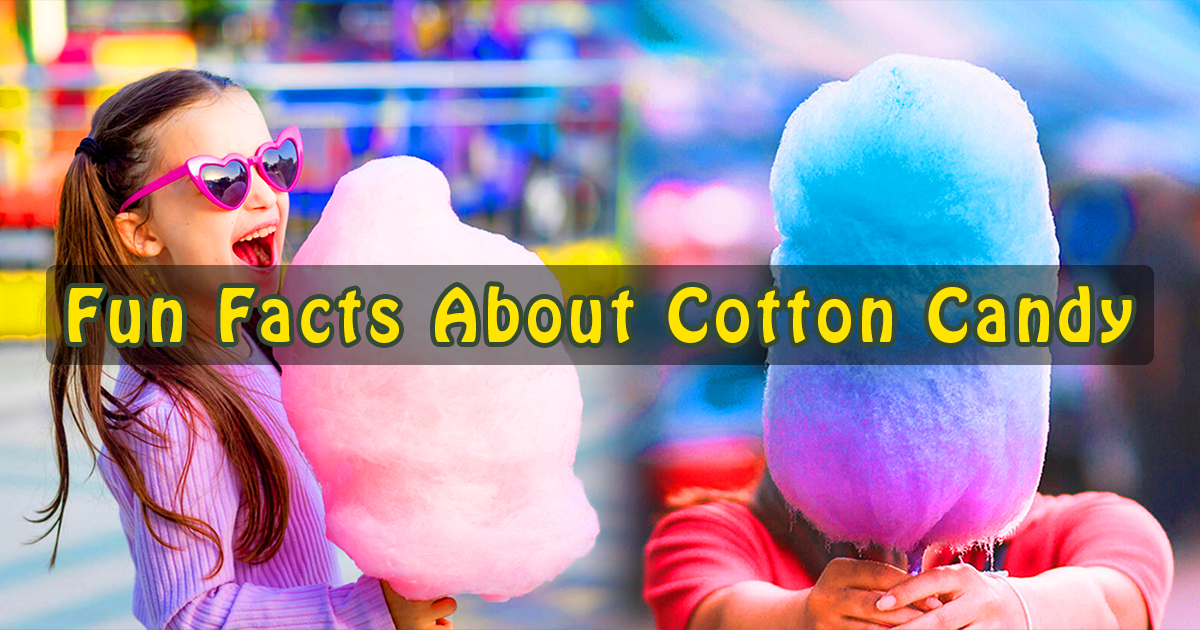Cotton candy, also known as candy floss, is a favorite treat for many, evoking memories of fairs, carnivals, and childhood fun. But did you know that this sugary delight has an interesting history and scientific background? In this blog post, we will explore everything about cotton candy, from its origins to how it’s made, and even answer some frequently asked questions. Let’s dive into the sweet world of cotton candy and candy floss!
What is Cotton Candy?
Cotton candy, or candy floss, is a sugary treat that is made by spinning sugar at high speeds until it forms thin strands. These strands are collected and served in a fluffy, cloud-like form, which melts in your mouth. It’s made from simple ingredients—sugar, food coloring, and flavoring—but the process behind it is what gives it that magical texture.
Why is it Called Candy Floss in Some Countries?
In the United States, this fluffy treat is known as cotton candy, while in the UK, it’s referred to as candy floss. Both terms reflect the treat’s light, fibrous texture, but the difference in name largely comes down to regional language preferences. Despite these variations, the sugary experience remains the same worldwide.
The History of Cotton Candy (Candy Floss)
Cotton candy may seem like a modern invention, but it actually has roots dating back to the 18th century. However, it wasn’t until 1897 that modern cotton candy as we know it was invented by William Morrison, a dentist, and John C. Wharton, a confectioner. Together, they created a machine that could melt sugar and spin it into thin strands. The two debuted their creation at the 1904 World’s Fair, where it was an instant success.
How Cotton Candy Became a Carnival Staple
Cotton candy’s popularity skyrocketed at fairs and carnivals due to its fun, whimsical nature and the ease of mass production using the cotton candy machine. Its affordability and ability to spark joy made it an instant classic at festivals and events.
The Science Behind Cotton Candy
Cotton candy is made through a fascinating process. It starts with regular granulated sugar, which is melted at high temperatures in a specialized machine. Once the sugar reaches its liquid state, the machine spins the liquid through tiny holes while rapidly cooling it, forming fine strands of sugar that stick together and puff up. This process creates the familiar fluffy, light texture that we all love.
What Ingredients Are Used in Candy Floss?
The basic ingredients for cotton candy include:
- Granulated sugar
- Food coloring (optional)
- Flavoring (optional)
Some of the most popular flavors include classic vanilla, bubblegum, and fruit flavors like strawberry and blue raspberry. Specialty cotton candy may even feature unique flavors like coffee, sour apple, or tropical fruits.
Cotton Candy vs Candy Floss: What’s the Difference?
Many people wonder if there is any difference between cotton candy and candy floss beyond the name. In reality, the two terms refer to the same product. However, in some regions, the name candy floss may also refer to a slightly different texture or production method, but for the most part, they are identical.
Does the Taste or Texture Differ?
The taste and texture of cotton candy or candy floss can vary slightly depending on the brand or flavor, but the core fluffy, melt-in-your-mouth experience remains consistent worldwide.
How to Make Cotton Candy at Home
Making cotton candy at home is easier than you might think, especially with the availability of affordable cotton candy machines. Here’s a simple step-by-step guide to making your own homemade cotton candy.
- Gather Your Ingredients: You’ll need sugar, food coloring, and flavoring if desired.
- Heat the Sugar: Use a cotton candy machine to heat and melt the sugar.
- Spin the Sugar: As the sugar melts and spins through the machine, it will form thin strands.
- Collect the Cotton Candy: Use a cone or stick to gather the spun sugar into a fluffy shape.
Best Machines for Making Candy Floss at Home
If you’re interested in making cotton candy at home, some of the best machines to consider include:
- Nostalgia Electrics Retro Hard & Sugar-Free Candy Cotton Candy Maker
- VIVO Cotton Candy Machine
- Clevr Commercial Cotton Candy Machine
These machines offer varying levels of production power and features, making them ideal for home use.
Popular Cotton Candy Flavors to Try
Beyond the traditional flavors of cotton candy, there are many unique and exciting options to explore. Some popular flavors include:
- Blue Raspberry
- Strawberry
- Bubblegum
- Sour Apple
- Pineapple
Specialty flavors like cotton candy bacon, lavender, and even pickle-flavored cotton candy have gained popularity in recent years.
Is Cotton Candy Vegan?
Many people wonder if cotton candy is vegan-friendly, and the answer is yes—most cotton candy is vegan. The primary ingredient is sugar, which doesn’t contain any animal products. However, it’s always important to check the food coloring and flavorings, as some might include animal-derived ingredients.
Vegan Alternatives for Cotton Candy
For those seeking vegan options, it’s recommended to use plant-based food colorings and natural flavorings. Many companies now produce fully vegan-friendly cotton candy that is free from any animal-based ingredients.
Cotton Candy Nutrition Facts and Health Concerns
While cotton candy is a fun and delicious treat, it’s important to recognize that it’s essentially spun sugar. A standard serving of cotton candy contains about 100 calories and no fat, but it’s high in sugar content. Eating cotton candy occasionally is fine, but regular consumption can contribute to tooth decay and other health issues.
Is Cotton Candy Bad for Your Health?
Cotton candy isn’t particularly harmful when enjoyed in moderation. Since it’s mostly sugar, consuming large quantities can lead to spikes in blood sugar and potential dental problems. However, as an occasional treat, it poses minimal risk.
Cotton Candy Around the World
While cotton candy, or candy floss, is a beloved treat in many countries, there are interesting variations found across the globe. For instance, in China, a unique form of artistic cotton candy is made by layering different colors of spun sugar into intricate, flower-like shapes. This form of cotton candy art has gained significant popularity for its beautiful and almost too-pretty-to-eat appearance.
In Turkey, a similar treat called pişmaniye resembles cotton candy, though it is made from a mixture of flour and sugar. Unlike the light and fluffy texture of cotton candy, pişmaniye has a denser consistency and is often flavored with nuts like pistachios.
International Festivals Celebrating Cotton Candy
Cotton candy is so beloved that there are entire festivals dedicated to it. In Japan, the Cotton Candy Art Festival showcases elaborate designs spun by cotton candy artists. These festivals bring cotton candy enthusiasts together to marvel at the creative and delicious variations of this popular treat.
Similarly, the Texas State Fair in the United States is known for its massive selection of cotton candy flavors, sizes, and even sculptures made entirely out of the spun sugar treat. Visitors can experience unique flavors such as maple bacon or coconut-lime, pushing the boundaries of traditional cotton candy.
The Future of Cotton Candy
As food trends evolve, so too does cotton candy. In recent years, there has been a push for healthier alternatives, with some companies developing sugar-free or natural cotton candy made from organic ingredients and no artificial colorings. This shift appeals to health-conscious consumers who want to enjoy the nostalgic flavors of cotton candy without the guilt.
In addition, the crossover between cotton candy and cocktails is gaining momentum. Bartenders are incorporating cotton candy into drinks as a sweet garnish that melts into the beverage, creating a fun, whimsical experience for customers.
Fun Facts About Cotton Candy
Cotton candy has a fascinating history and some fun trivia to go along with it:
- World Record: The largest cotton candy ever made weighed over 3,500 pounds!
- International Variations: In Iran, a similar treat called “pashmak” is made from sesame instead of sugar.
- National Cotton Candy Day: Did you know that December 7th is National Cotton Candy Day in the U.S.?
- Dental Irony: One of the inventors of cotton candy, William Morrison, was a dentist!
- Cotton Candy Art: In Japan, intricate shapes like animals and flowers are crafted from cotton candy.
Conclusion: Why Cotton Candy and Candy Floss are Timeless Treats
Cotton candy, or candy floss, continues to be a favorite treat for people of all ages. Its light, fluffy texture and sweet flavor make it the perfect indulgence for special occasions. Whether enjoyed at a carnival or made at home, the magic of cotton candy never fades. With its fascinating history and endless flavor possibilities, this timeless treat will always hold a special place in our hearts.
Frequently Asked Questions (FAQs)
- What is the origin of the term “candy floss”?
The term “candy floss” comes from the UK, referring to the fluffy, fibrous texture of spun sugar. In the U.S., it’s called cotton candy. - Can I make cotton candy without a machine?
While it’s difficult to replicate the spinning technique at home without a machine, there are DIY methods to create a similar product using a whisk or hand-spinning method, but they aren’t as effective. - What are the best cotton candy machines for beginners?
Some of the best beginner-friendly cotton candy machines include the Nostalgia Electrics Retro Cotton Candy Maker and the VIVO Cotton Candy Machine. - Is cotton candy gluten-free?
Yes, cotton candy is gluten-free, as its main ingredient is sugar. However, always check the additional flavorings or colorings for any gluten-related additives. - What is the shelf life of cotton candy?
Cotton candy should be eaten fresh for the best texture. If stored in an airtight container, it can last for up to 2-3 weeks before it begins to harden and lose its fluffiness.
Internal Link: Don’t forget to check out more fun articles on our homepage.
Philip John is the dedicated admin of My Read Magazine, ensuring every article meets the highest standards before publication. With years of editorial experience, he carefully reviews each piece for accuracy, clarity, and relevance. His commitment to quality helps maintain the magazine’s reputation as a trusted and reliable source of information for readers worldwide.




